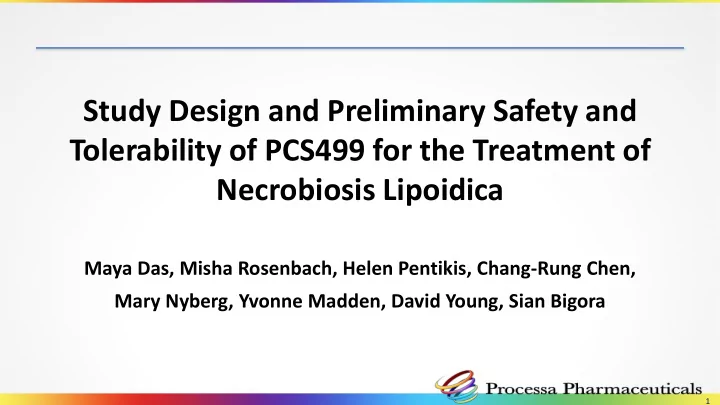

Study Design and Preliminary Safety and Tolerability of PCS499 for the Treatment of Necrobiosis Lipoidica Maya Das, Misha Rosenbach, Helen Pentikis, Chang-Rung Chen, Mary Nyberg, Yvonne Madden, David Young, Sian Bigora 1
Authors and Disclosures • Maya Das, MD, JD • Misha Rosenbach, MD – Processa Pharmaceuticals (Employee, – Perelman School of Medicine, Stock) University of Pennsylvania • Helen Pentikis, PhD – Processa Pharmaceuticals (Consultant) – Processa Pharmaceuticals (Employee, • Chang-Rung Chen, PhD Stock) – Processa Pharmaceuticals (Employee, • Mary Nyberg, MBA Stock) – Processa Pharmaceuticals (Employee, • Yvonne Madden, BS Stock) – Processa Pharmaceuticals (Employee, • David Young, PharmD, PhD Stock) – Processa Pharmaceuticals (Employee, • Sian Bigora, PharmD Board of Directors, Stock) – Processa Pharmaceuticals (Employee, Stock) 2
Background/Summary • Necrobiosis lipoidica (NL) is a chronic, disfiguring condition characterized by plaques with an atrophic yellow center, usually on the shin – No FDA-approved therapies exist for NL – Some evidence of pentoxifylline (PTX) efficacy in NL exists; however, dose limiting adverse events at 400 mg TID (1200 mg daily) preclude administration of higher doses • PCS499 is a deuterated form of the primary metabolite of PTX • Administration of PCS499 produces higher concentrations/exposures of active moieties compared to PTX. Active moieties inhibit the secretion of pro-inflammatory cytokines (i.e., TNF- α, IFN - γ), increase blood oxygenation, and improve blood flow. 1800 mg daily dose of PCS499 (administered as 900 mg BID or 600 mg TID) was found to be safe & tolerable in healthy volunteers A study to assess safety & tolerability of 1800 mg daily of PCS499 in NL patients is currently ongoing 3
Phase 1 – Exposure and Safety Study in Healthy Volunteers • Design/Methods: – Open-label, 3-period sequential crossover study to assess the pharmacokinetics (PK), exposure, and safety – Regimens of 900 mg BID and 600 mg TID of PCS499 & 400 mg TID of PTX in fed healthy volunteers – Subjects received a single dose on Days 1 and 4 and multiple doses on Days 2 and 3 • Results: PK Parameters (Geometric Mean) for Active Moieties (Day 4) PCS499 900 mg BID PCS499 600 mg TID PTX 400 mg TID (n=5) (n=5) (n=6) Cmax/Dose (ng/mL/mg) 2.11 2.48 1.02 AUC(0-24)/Dose (ng.h/mL/mg) 19.3 16.2 7.32 2.6x higher 2.2x higher Safety – Treatment emergent adverse events (TEAE) PCS499 900 mg BID PCS499 600 mg TID PTX 400 mg TID (n=5) (n=5) (n=6) At least 1 TEAE 2 2 2 At least 1 TEAE related to drug 1 (mild nausea) 0 1 (mild headache) 1800 mg daily dose of PCS499 (administered as 900 mg BID or 600 mg TID) was well tolerated despite higher active moiety exposures on a per mg per day basis 4
Phase 2 - Safety and Tolerability Study in NL Patients • Overall Design: – Open-label, study to assess the safety and tolerability of daily dosing of 1800 mg PCS499 in NL patients – 6 month treatment period (+ 6 month extension period) – Exploratory measures of efficacy and quality of life will also be assessed • Study population: – Approximately 12 NL patients (~6-9 patients without ulceration and ~3-6 patients with ulceration) – Key Inclusion criteria: • Biopsy-confirmed diagnosis of NL • Reference NL lesion with at least mild inflammation and minimum size of 10 cm 2 – Key Exclusion criteria: • Current or previous (within 4 weeks of Baseline) treatment with: ▪ Oral, topical, or intralesional corticosteroids; Oral or topical retinoid ▪ Systemic pentoxifylline, theophylline, or cilostazol; Systemic or topical immunosuppressants • Current or previous (within 12 weeks of Baseline) treatment with any biologic therapy • Phototherapy/photochemotherapy (NBUVB, UVB, PUVA), skin grafting, or other surgical procedure (other than debridement) within 6 weeks prior to Baseline • Status: **Currently Enrolling** Visit https://clinicaltrials.gov/ct2/show/NCT03698864 5
Recommend
More recommend